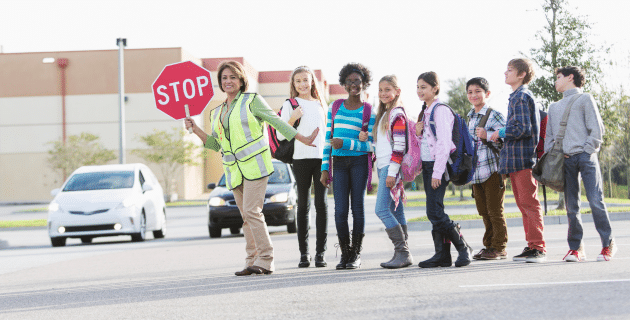If you haven’t thought about crossing guards, school buses, and kids walking to school for a while, it’s time to refresh your memory. You’ll want to review important safety tips as everyone heads back to class.
From school zones to buses, bikes, and more, this guide shares the basics about back-to-school traffic safety. Read on to find out what you need to know.
Learn where the school zones are.
A school zone is an area on the street near a school where students typically travel on foot or by bike, skateboard, etc. It is typically located one or two blocks around the school.
- Look for signs and road markings that indicate a school zone.
- Prepare to slow down. School zones have reduced speed limits during certain hours like drop-off and dismissal.
- Watch for children, who may cross without looking. Remember that not all students use crosswalks, and not all crosswalks have crossing guards.
- Put your phone away. Texting in a school zone carries a big fine.
Be aware of the time of day.
You may drive past the school every day, but you must be extra vigilant when school is in session.
- Pay attention to when your local schools start and end the day. Know the times that students typically arrive and leave. Remember that schools sometimes have early dismissal.
- During these times, be careful backing out of driveways and traveling through the neighborhood near schools, playgrounds, and parks.
- You may even decide to take a different route to avoid the school at busy times.
Navigate school parking lots carefully.
Rushed, distracted parents and children who may not understand traffic rules create safety hazards in school parking lots. Learn and follow your school’s rules for dropping off, picking up and parking.
- Go slowly past parked cars. Children can appear out of nowhere.
- Don’t make U-turns and don’t pass a vehicle unloading passengers. These are unpredictable moves that other cars and pedestrians will not expect.
- Don’t double park as you will block the view, and ability to move, for others.
- Don’t honk your horn. You could startle those around you.
- Avoid the emergency lanes or handicap spots unless you are authorized to use them.
Know the rules for sharing the road with school buses.
It’s likely you’ll be sharing the road with school buses. These larger vehicles have their own special rules. Check your state’s laws for specifics.
- Keep a safe distance behind school buses.
- Avoid cutting in front of school buses even if your car can fit. Never pass a stopped school bus in either direction.
- Watch for yellow flashing lights that signal a bus is about to stop. By the time the bus flashes red lights, you should be stopped and that’s true for both directions.
- Be aware of a bus driver’s blind spots. They are located around the front, sides, and back of the vehicle.
Know the rules for sharing the road with bicycles.
You will likely encounter kids on bicycles as you drive. Be aware that they may or may not understand the traffic rules.
- Learn biking hand signals so you will know what a cyclist is communicating. Know that some cyclists will turn without signaling, too.
- Watch for bicycles that unexpectedly come from driveways and between parked cars.
- Allow plenty of room and slow down when you are passing a bicycle.
- Check your mirrors and blind spots before turning. Stay out of bike lanes.
- After you park your car, check your side mirrors before you open your door. That way, you hopefully won’t knock into a bicyclist with your door.
Other Safety Tips
You can be proactive to keep everyone safe during back-to-school traffic and year-round. Here are some additional tips.
- Expect the unexpected. Children are unpredictable.
- Teach your children about safety around cars.
- Teach your children how to share the road as a bicyclist and on their skateboards.
- Consider carpooling to reduce the traffic in the school parking lot.
- Give yourself extra time. When you’re not in a rush, it’s easier to make clear headed decisions.
Finally, keep your car insurance up to date for added peace of mind. After all, you’re carrying precious cargo.
This article is furnished by California Casualty, providing auto and home insurance to educators, law enforcement officers, firefighters, and nurses. Get a quote at 1.866.704.8614 or www.calcas.com.
- California Casualty Earns Financial Stability Rating® of A, Exceptional, From Demotech, Inc. - April 28, 2025
- Music & Arts Grant Recipients – 2024 - December 13, 2024
- Understanding Auto and Home Insurance Rate Changes - December 3, 2024

